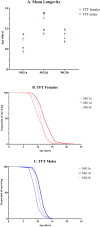Toward the Development of the Trojan Female Technique in Pest Insects: Male-Specific Influence of Mitochondrial Haplotype on Reproductive Output in the Seed Beetle Acanthoscelides obtectus
- PMID: 39726737
- PMCID: PMC11671214
- DOI: 10.1111/eva.70065
Toward the Development of the Trojan Female Technique in Pest Insects: Male-Specific Influence of Mitochondrial Haplotype on Reproductive Output in the Seed Beetle Acanthoscelides obtectus
Abstract
Biocontrol techniques that impair reproductive capacity of insect pests provide opportunities to control the dynamics of their populations while minimizing collateral damage to non-target species and the environment. The Trojan Female Technique, or TFT, is a method of the trans-generational fertility-based population control through the release of females that carry mitochondrial DNA mutations that negatively affect male, but not female, reproductive output. TFT is based on the evolutionary hypothesis that, due to maternal inheritance of mitochondria, mutations which are beneficial or neutral in females but harmful in males can accumulate in the mitochondrial genome without selection acting against them. Although TFT has been theoretically substantiated, empirical work to date has focused only on Drosophila melanogaster populations, while the existence of male-biased mutations and the TFT approach in economically important pest species remain unexplored. Here, we examined the sex-specific effects of three distinct and naturally occurring mitochondrial haplotypes (MG1a, MG1d, and MG3b) on several reproductive and life history traits in the seed beetle Acanthoscelides obtectus. Our results revealed that males harboring the MG3b mitotype exhibited lower early fecundity and fertility, while there were no effects on females or longevity in either sex. Our experiments provide support for the existence of the mitochondrial variant that specifically impairs male reproductive output in pest insects. These results can be harnessed to further develop TFT as a novel form of biocontrol with broad applicability to economic pests and disease vector insects.
Keywords: Mother's Curse; longevity; male infertility; mitonuclear interactions; pest control; sex‐specific effects.
© 2024 The Author(s). Evolutionary Applications published by John Wiley & Sons Ltd.
Conflict of interest statement
The authors declare no conflicts of interest.
Figures



Similar articles
-
The Trojan Female Technique for pest control: a candidate mitochondrial mutation confers low male fertility across diverse nuclear backgrounds in Drosophila melanogaster.Evol Appl. 2015 Oct;8(9):871-80. doi: 10.1111/eva.12297. Epub 2015 Aug 26. Evol Appl. 2015. PMID: 26495040 Free PMC article.
-
Introduction of a male-harming mitochondrial haplotype via 'Trojan Females' achieves population suppression in fruit flies.Elife. 2017 May 3;6:e23551. doi: 10.7554/eLife.23551. Elife. 2017. PMID: 28467301 Free PMC article.
-
Mitochondrial effects on fertility and longevity in Tigriopus californicus contradict predictions of the mother's curse hypothesis.Proc Biol Sci. 2022 Nov 30;289(1987):20221211. doi: 10.1098/rspb.2022.1211. Epub 2022 Nov 16. Proc Biol Sci. 2022. PMID: 36382523 Free PMC article.
-
Maternal inheritance of mitochondria: implications for male fertility?Reproduction. 2018 Apr;155(4):R159-R168. doi: 10.1530/REP-17-0600. Reproduction. 2018. PMID: 29581388 Review.
-
Mother's Curse effects on lifespan and aging.Front Aging. 2024 Mar 8;5:1361396. doi: 10.3389/fragi.2024.1361396. eCollection 2024. Front Aging. 2024. PMID: 38523670 Free PMC article. Review.
Cited by
-
Cytogenetic and Molecular Characterization of Sphaerophoria rueppellii (Diptera, Syrphidae).Insects. 2025 Jun 8;16(6):604. doi: 10.3390/insects16060604. Insects. 2025. PMID: 40559034 Free PMC article.
References
-
- Bourtzis, K. , Lees R. S., Hendrichs J., and Vreysen M. J.. 2016. “More Than One Rabbit out of the Hat: Radiation, Transgenic and Symbiont‐Based Approaches for Sustainable Management of Mosquito and Tsetse Fly Populations.” Acta Tropica 157: 115–130. 10.1016/j.actatropica.2016.01.009. - DOI - PubMed
LinkOut - more resources
Full Text Sources

